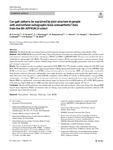Mostrar o rexistro simple do ítem
Can gait patterns be explained by joint structure in people with and without radiographic knee osteoarthritis?: data from the IMI-APPROACH cohort
| dc.contributor.author | Jansen, Mylène P. | |
| dc.contributor.author | Hodgins, Diana | |
| dc.contributor.author | Mastbergen, Simon C. | |
| dc.contributor.author | Kloppenburg, Margreet | |
| dc.contributor.author | Blanco García, Francisco J | |
| dc.contributor.author | Haugen, Ida K. | |
| dc.contributor.author | Berenbaum, Francis | |
| dc.contributor.author | Eckstein, Felix | |
| dc.contributor.author | Roemer, Frank W. | |
| dc.contributor.author | Wirt, Wolfgang | |
| dc.date.accessioned | 2024-04-05T08:29:17Z | |
| dc.date.available | 2024-04-05T08:29:17Z | |
| dc.date.issued | 2024-03-27 | |
| dc.identifier.citation | Jansen MP, Hodgins D, Mastbergen SC, Kloppenburg M, Blanco FJ, Haugen IK, Berenbaum F, Eckstein F, Roemer FW, Wirth W. Can gait patterns be explained by joint structure in people with and without radiographic knee osteoarthritis?: data from the IMI-APPROACH cohort. Skeletal Radiol. 2024 Mar 27. Epub ahead of print. | es_ES |
| dc.identifier.issn | 0364-2348 | |
| dc.identifier.uri | http://hdl.handle.net/2183/36070 | |
| dc.description.abstract | [Abstract] Objective: To determine the association between joint structure and gait in patients with knee osteoarthritis (OA). Methods: IMI-APPROACH recruited 297 clinical knee OA patients. Gait data was collected (GaitSmart®) and OA-related joint measures determined from knee radiographs (KIDA) and MRIs (qMRI/MOAKS). Patients were divided into those with/without radiographic OA (ROA). Principal component analyses (PCA) were performed on gait parameters; linear regression models were used to evaluate whether image-based structural and demographic parameters were associated with gait principal components. Results: Two hundred seventy-one patients (age median 68.0, BMI 27.0, 77% female) could be analyzed; 149 (55%) had ROA. PCA identified two components: upper leg (primarily walking speed, stride duration, hip range of motion [ROM], thigh ROM) and lower leg (calf ROM, knee ROM in swing and stance phases). Increased age, BMI, and radiographic subchondral bone density (sclerosis), decreased radiographic varus angle deviation, and female sex were statistically significantly associated with worse lower leg gait (i.e. reduced ROM) in patients without ROA (R2 = 0.24); in ROA patients, increased BMI, radiographic osteophytes, MRI meniscal extrusion and female sex showed significantly worse lower leg gait (R2 = 0.18). Higher BMI was significantly associated with reduced upper leg function for non-ROA patients (R2 = 0.05); ROA patients with male sex, higher BMI and less MRI synovitis showed significantly worse upper leg gait (R2 = 0.12). Conclusion: Structural OA pathology was significantly associated with gait in patients with clinical knee OA, though BMI may be more important. While associations were not strong, these results provide a significant association between OA symptoms (gait) and joint structure. | es_ES |
| dc.language.iso | spa | es_ES |
| dc.publisher | Springer Nature | es_ES |
| dc.relation.uri | https://doi.org/10.1007/s00256-024-04666-8 | es_ES |
| dc.rights | Creative Commons Attribution 4.0 International License (CC-BY 4.0) | es_ES |
| dc.rights.uri | http://creativecommons.org/licenses/by/4.0/ | |
| dc.subject | Gait | es_ES |
| dc.subject | Osteoarthritis | es_ES |
| dc.subject | Pathology | es_ES |
| dc.subject | ROM | es_ES |
| dc.subject | Structure | es_ES |
| dc.title | Can gait patterns be explained by joint structure in people with and without radiographic knee osteoarthritis?: data from the IMI-APPROACH cohort | es_ES |
| dc.type | info:eu-repo/semantics/article | es_ES |
| dc.rights.access | info:eu-repo/semantics/openAccess | es_ES |
| UDC.journalTitle | Skeletal Radiology | es_ES |
| UDC.coleccion | Investigación | |
| UDC.departamento | Fisioterapia, Medicina e Ciencias Biomédicas | |
| UDC.grupoInv | Reumatoloxía (INIBIC) | |
| UDC.grupoInv | Grupo de Investigación en Reumatoloxía e Saúde (GIR-S) | |
| UDC.institutoCentro | INIBIC - Instituto de Investigacións Biomédicas de A Coruña |
Ficheiros no ítem
Este ítem aparece na(s) seguinte(s) colección(s)
-
Investigación (FCS) [1262]







